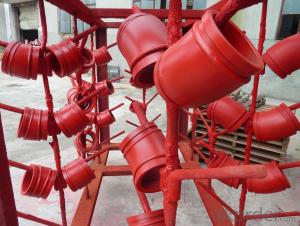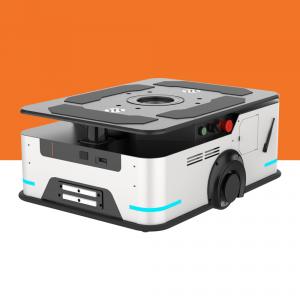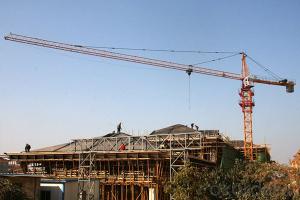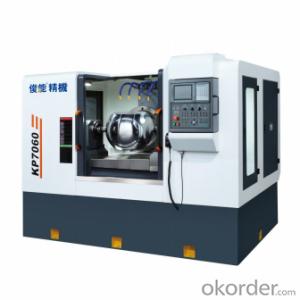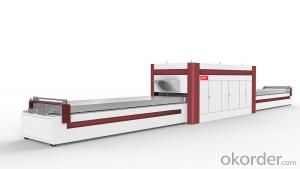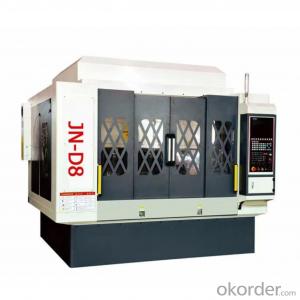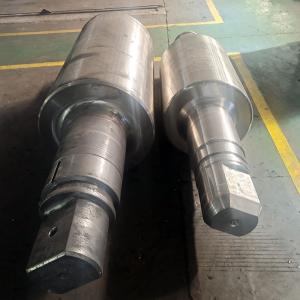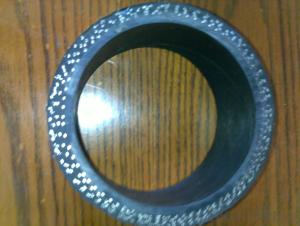Twin Wall Elbow for Concrete Pump R275 45DGR
- Loading Port:
- Tianjin
- Payment Terms:
- TT OR LC
- Min Order Qty:
- 80 pc
- Supply Capability:
- 5000 pc/month
OKorder Service Pledge
OKorder Financial Service
You Might Also Like
Twin Wall Elbow (Twin Wall Flange)
(1) Material: Q235 (outside) + GCr15(inside)
(2) Thickness: 3mm (outside) + 9mm (inside)
(3) Technology: Quenching under high temperature
(4) Characteristics: the inner rigidity to 63 HRC; the outside has so high toughness to keep the inner.
(5) Matched with: Twin wall flange, Alloy (GCr15) + 20#
(6) Working Pressure:170bar
(7) Service life: above 60,000 cubic meters.
(8) Package: PP woven bag and plastic cap
Twin wall elbow is created with research of us and need of the market. Its service life and working pressure are better than the casting. Besides, We can supply 90D, 45D, 30D, 25D, 20D, 15D, 10D. And it can be used for PM, JUNJIN, Schwing, Cifa, Sany, ect.
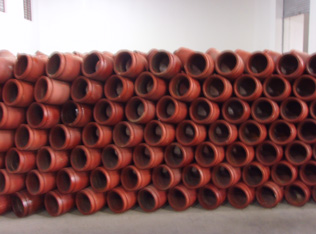

- Q:Can concrete pump spare parts be ordered in bulk quantities for future use?
- Yes, concrete pump spare parts can be ordered in bulk quantities for future use. This can be beneficial to ensure a continuous supply of spare parts, reduce downtime, and potentially negotiate better pricing and discounts.
- Q:How do I maintain and clean concrete pump spare parts?
- To ensure the long life and smooth operation of concrete pump spare parts, it is crucial to maintain and clean them. Follow these steps to accomplish this: 1. Conduct Routine Inspections: Begin by carefully examining the spare parts for signs of wear, cracks, or damage. This step is essential for identifying potential issues that require immediate attention. 2. Apply Lubrication: To minimize friction and prevent seizing, apply lubricant to moving parts like bearings, pistons, and cylinders. 3. Thoroughly Clean: Employ a high-pressure washer or hose to thoroughly clean the spare parts. Eliminate any accumulated dirt, debris, or concrete residue, paying particular attention to hard-to-reach areas. 4. Prevent Rust: Guard metal parts against corrosion by applying a rust preventive coating. This step is especially important if the spare parts are exposed to moisture or inclement weather conditions. 5. Proper Storage: Store the spare parts in a clean and dry location to shield them from moisture, dust, and other contaminants. Avoid directly stacking them on the ground to prevent damage. 6. Regular Maintenance: Establish a maintenance schedule and adhere to it. Adhere to the manufacturer's guidelines for routine tasks such as replacing filters, checking oil levels, and inspecting seals. Regular maintenance aids in the detection of potential issues before they escalate into major problems. 7. Seek Professional Assistance: If you are uncertain about how to maintain or clean specific spare parts, it is advisable to seek professional assistance. Concrete pump spare parts are intricate and necessitate expert handling. Remember, proper maintenance and regular cleaning of concrete pump spare parts not only prolong their lifespan but also enhance the overall performance and efficiency of your concrete pump.
- Q:What are the different types of concrete pump hopper vibrators?
- There are several different types of concrete pump hopper vibrators available on the market. These vibrators are designed to help keep the concrete flowing smoothly through the hopper and into the pumping system. 1. Electric Vibrators: These are the most common type of hopper vibrators and are powered by electricity. They are typically attached to the side of the hopper and use an electric motor to create vibrations that help move the concrete. 2. Pneumatic Vibrators: These vibrators are powered by compressed air and are often used in situations where electricity is not readily available. They work by using air pressure to create vibrations that help keep the concrete flowing. 3. Hydraulic Vibrators: These vibrators are powered by hydraulic fluid and are often used in larger concrete pumping systems. They can be more powerful than electric or pneumatic vibrators and are often used in heavy-duty applications. 4. Rotary Vibrators: These vibrators work by spinning an eccentric weight, creating vibrations that help move the concrete. They are often used in situations where a high frequency of vibration is required. 5. Turbine Vibrators: These vibrators use a turbine mechanism to create vibrations. They are often used in situations where a low frequency of vibration is needed. 6. Ball Vibrators: These vibrators use a ball inside a housing to create vibrations. They are often used in smaller concrete pumping systems and can be easily mounted to the hopper. Overall, the type of concrete pump hopper vibrator that is best for a particular application will depend on factors such as the size and type of the concrete pumping system, the desired frequency and intensity of vibration, and the availability of power sources.
- Q:How is a concrete pump pipe different from a regular pipe?
- A concrete pump pipe is specifically designed for pumping high-pressure concrete mixture from a concrete pump truck to the desired location. Unlike a regular pipe, a concrete pump pipe is made of high-quality and durable materials such as hardened steel or alloy, which can withstand the high pressures and abrasion caused by the concrete mixture. One key difference between a concrete pump pipe and a regular pipe is the thickness of the walls. Concrete pump pipes have thicker walls to ensure they can handle the high pressure and abrasive nature of the concrete mixture. Regular pipes, on the other hand, are designed for various purposes such as water or gas transportation and therefore may not have the same level of thickness and durability. Additionally, concrete pump pipes often come with different end connections, such as flanges or couplings, to allow for easy connection and disconnection to the concrete pump truck and other pipeline components. This ensures a secure and leak-free transfer of the concrete mixture. Furthermore, concrete pump pipes may also have special design features to enhance their performance and longevity. These features can include wear-resistant linings, heat treatment, or galvanization to prevent corrosion and extend the lifespan of the pipe. In summary, a concrete pump pipe differs from a regular pipe in terms of its materials, thickness, end connections, and design features. These differences enable concrete pump pipes to handle the unique requirements of pumping high-pressure concrete mixtures efficiently and effectively.
- Q:Do concrete pump spare parts come with a warranty?
- Yes, concrete pump spare parts typically come with a warranty. The specific duration and coverage of the warranty may vary depending on the manufacturer and supplier. It is advisable to check the product specifications or consult with the supplier to understand the warranty terms for concrete pump spare parts.
- Q:What is the function of a concrete pump hopper agitator shaft bearing?
- The function of a concrete pump hopper agitator shaft bearing is to provide support and facilitate smooth rotation of the agitator shaft, ensuring effective mixing of the concrete in the hopper.
- Q:How can a faulty outrigger affect the stability of the pump?
- A faulty outrigger can significantly affect the stability of a pump. The outrigger is an essential component that helps to support and balance the pump during operation. It acts as a stabilizer and prevents the pump from tipping over or vibrating excessively. If the outrigger is faulty, it may not provide the necessary support and stability required for the pump to function properly. This can lead to various stability issues. For example, the pump may become more prone to tipping over, especially if it is subjected to uneven surfaces or strong vibrations. This can be extremely dangerous, especially if the pump is dealing with hazardous or flammable materials. Additionally, a faulty outrigger can cause the pump to vibrate excessively. Vibrations can lead to increased wear and tear on the pump, resulting in premature failure of critical components. Excessive vibrations can also cause damage to the surrounding infrastructure or equipment, leading to costly repairs or even accidents. Furthermore, a faulty outrigger can affect the accuracy and efficiency of the pump's operation. If the pump is not properly stabilized, it may not be able to maintain a consistent flow rate or pressure, affecting its performance. This can result in inefficiencies, increased energy consumption, and even reduced productivity. In conclusion, a faulty outrigger can have a detrimental impact on the stability of a pump. It can increase the risk of accidents, cause excessive vibrations, and affect the pump's performance and efficiency. Regular maintenance and inspections are crucial to ensure that the outrigger and other support systems are functioning correctly to maintain the stability and reliability of the pump.
- Q:Can concrete pump spare parts be coated with UV-resistant coatings for outdoor applications?
- Concrete pump spare parts can benefit from the application of UV-resistant coatings to protect them from the damaging effects of UV radiation. These coatings are specially designed to prevent fading, cracking, and deterioration over time. By coating the spare parts, they are shielded from prolonged exposure to sunlight and other environmental factors, thus extending their lifespan and ensuring optimal performance outdoors. Furthermore, these coatings offer additional protection against weathering, including moisture, temperature fluctuations, and chemical exposure. As a result, it is highly recommended to coat concrete pump spare parts with UV-resistant coatings in order to enhance their durability and maintain their functionality when used outside.
- Q:How often should a hopper filter be cleaned or replaced?
- The frequency at which a hopper filter should be cleaned or replaced depends on various factors such as the type of hopper, the nature of contaminants, and the usage pattern. As a general guideline, it is recommended to clean or replace the hopper filter at least once every three to six months. However, if the hopper is used in a particularly dusty or dirty environment, or if it handles materials that produce a high level of debris, more frequent cleaning or replacement may be necessary. Regular inspection of the hopper filter is crucial to determine the accumulation of particles and the effectiveness of filtration. Additionally, if the hopper filter starts to show signs of damage or wear, it should be replaced immediately to maintain optimal performance and prevent any potential contamination. Ultimately, it is advisable to refer to the manufacturer's guidelines and recommendations for the specific hopper filter being used.
- Q:How long does it take to replace a specific concrete pump spare part?
- The time it takes to replace a specific concrete pump spare part can vary depending on factors such as the complexity of the part, availability of the replacement, and the experience of the technician. Generally, it can take anywhere from a few hours to a few days for the replacement process to be completed.
1. Manufacturer Overview |
|
|---|---|
| Location | |
| Year Established | |
| Annual Output Value | |
| Main Markets | |
| Company Certifications | |
2. Manufacturer Certificates |
|
|---|---|
| a) Certification Name | |
| Range | |
| Reference | |
| Validity Period | |
3. Manufacturer Capability |
|
|---|---|
| a)Trade Capacity | |
| Nearest Port | |
| Export Percentage | |
| No.of Employees in Trade Department | |
| Language Spoken: | |
| b)Factory Information | |
| Factory Size: | |
| No. of Production Lines | |
| Contract Manufacturing | |
| Product Price Range | |
Send your message to us
Twin Wall Elbow for Concrete Pump R275 45DGR
- Loading Port:
- Tianjin
- Payment Terms:
- TT OR LC
- Min Order Qty:
- 80 pc
- Supply Capability:
- 5000 pc/month
OKorder Service Pledge
OKorder Financial Service
Similar products
New products
Hot products


